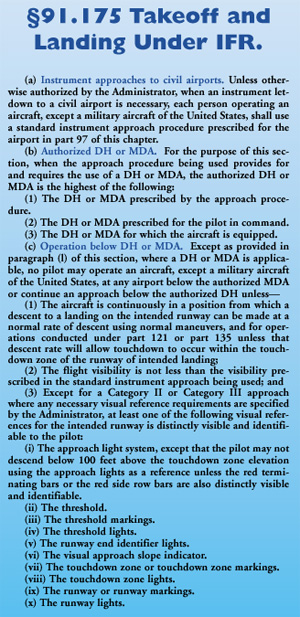Misunderstanding Part 91.175
by Cody Johnson
Reprinted with permission from FAA
Aviation News
 An
aircraft crashed several months ago while executing a locator/distance measuring
equipment (LOC/DME) approach. The aircraft descended to the minimum descent
altitude (MDA) then purportedly the pilot reported on the Cockpit Voice Recorder
(CVR) that he 'had the approach lights.' The aircraft continued a descent below
the MDA and struck a rising tree-covered hill a few miles from the end of the
runway. An
aircraft crashed several months ago while executing a locator/distance measuring
equipment (LOC/DME) approach. The aircraft descended to the minimum descent
altitude (MDA) then purportedly the pilot reported on the Cockpit Voice Recorder
(CVR) that he 'had the approach lights.' The aircraft continued a descent below
the MDA and struck a rising tree-covered hill a few miles from the end of the
runway.
In the course of the investigation, the National
Transportation Safety Board (NTSB) began evaluating Title 14 of the Code of
Federal Regulations (14 CFR) Section 91.175(c), 'Takeoff and Landing under IFR.'
They have asked the FAA to explain why the rule has, what they believe, an
unsafe provision. Specifically, the rule states that once a pilot, who is
established at MDA, sees the approach lights he can descend below the MDA to 100
feet above the touchdown zone elevation (TDZE):
This would lead one to believe that a pilot
could descend below the MDA several miles from the end of the runway based on
the fact that he saw some approach lights in a low visibility situation (night/IFR/rain).
That in fact is not the intent of the rule. The rule contains many provisions
and extensive criteria born over years of experience and accidents.
For example, the 100-foot restriction only
applies when using the approach lighting system. The reason is simply that the
approach lighting system isn't the runway; it's the environment prior to
reaching the runway. You need something else that will verify positive contact
and let you know where the end of the runway is. If you are only using the
approach lighting system and don't have the runway environment itself in sight,
you need either the red terminating bars or the red side row bars to go below
100 feet above the TDZE.
If you have any of the other elements indicated
in 14 CFR 91.175(c)(3), you do not have this restriction. Again, the aim of this
regulation is to require you to have positive contact with the runway and to be
able to identify the threshold. If you can see the threshold lights, touchdown
zone lights, runway lights, etc., then you are seeing something that is beyond
the threshold. If you are looking only at approach lights, you have no exact
idea of where the runway actually begins, hence the requirement.
If you have the threshold, threshold markings,
threshold lights, runway and identification lights (REIL), visual approach slope
indicator (VASI), touchdown zone (TDZ) or TDZ markings, TDZ lights, runway or
runway markings, or the runway lights, you are not restricted to the 100-foot
limitation.
If you reach decision height (DH) or the
applicable MDA and have the approach lights in sight, you may continue on your
descent, using those lights until reaching 100 feet above the TDZ elevation. At
that point, if you do not have the requisite red terminating bars or side row
bars, you are obligated to perform a missed approach. However, if when arriving
at 100 feet you have other elements visible as described above, then you may
continue, as you are no longer using only the approach lighting system. The
restriction applies when using the approach lighting system only, for your
visual reference. It's important to have this provision for those non-precision
approaches (VOR/ADF) with relatively high MDAs (500-700' height above touchdown
or HAT) so a pilot has a reasonable chance of complying with Section
91.175(c)(1).
Also applicable to this question is the very
important issue of what approach lighting systems (ALS) use, red terminating
bars or side row bars. You need this information when planning the approach, and
it is provided with the approach chart. The ALSF-1 (with sequenced flashing
lights) provides red terminating bars, and the ALSF-II provides side row bars.
The runway in question in this accident is equipped with a Medium Intensity
Approach Light System (MALS), which contains a green terminating bar and a
sequenced flasher'no red lights!
Section 91.129(e)(3), Operations in Class D
Airspace, is also extremely applicable in this accident. It says, 'An airplane
approaching to land on a runway served by a visual approach slope indicator
shall maintain an altitude at or above the glide slope until a lower altitude is
necessary for safe landing.'
If the pilot followed this rule he would be
alive today. Runway 36 at Kirksville is equipped with a VASI. Whether it was
working, or working properly, is a job for the investigators. But Section 91.175
was not the basis for this accident.
Coby Johnson is an Aviation Safety Inspector
with Flight Standards Flight Technologies and Procedures Division.
|